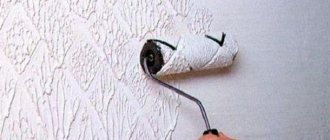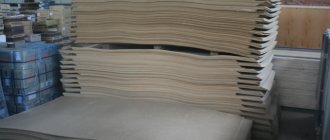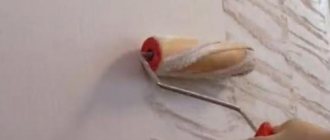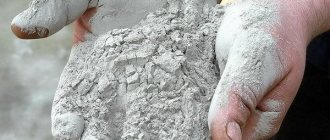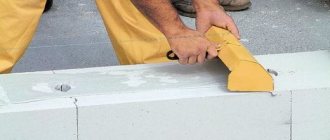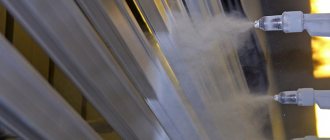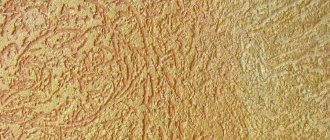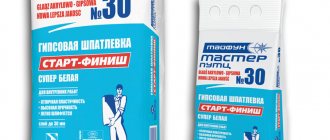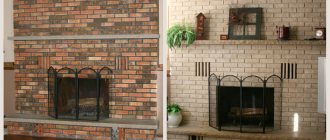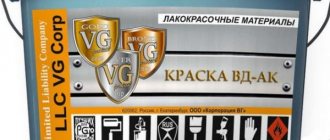Liquid putty is available in a ready-to-use form, which is of course very convenient. This solution has the consistency of thick sour cream; its use guarantees an excellent result, which dry materials cannot always provide.
The price of such a product is, of course, much higher than dry mixtures, but this largely compensates for the cost of effort and time when performing repair work. Another advantage of liquid putty for walls is a fairly long shelf life when opened, during which the putty does not lose its properties.
Purpose and application
Liquid putty is intended for applying the finishing layer of the mixture when treating walls on an already prepared base using primer solutions. Depending on the type of coating being processed, individual compositions are used; we will talk about the types of putties in the next paragraph.
Wall finishing with a liquid putty solution is used for the following types of base:
- tree;
- plastic;
- drywall;
- metal;
- polyester;
- aluminum;
- plastered walls.
Note! When performing repair work, it is necessary to select a liquid solution for a specific base and determine the type of treatment that will be carried out.
What is putty in liquid form?
Liquid putty for wall finishing
A liquid putty solution is a substance whose consistency resembles sour cream. The solution contains various additives that are complex in their chemical composition, which improve all the qualities of the material compared to other familiar wall finishing substances. You are unlikely to be able to mix such a solution with your own hands, since the preparation technology requires the use of specialized factory equipment.
If you decide to use such a newfangled material in your renovation, you can buy it completely ready-made at a hardware store.
In order to buy the right solution, you need to find out what types of it exist and what kind of work they are suitable for.
Please note that after opening the original packaging of the solution, it can be used for several months, but provided that the substance is stored in a tightly closed container, ensuring that no air gets inside.
Composition and technical characteristics
Liquid putty is a substance that has a creamy consistency. It contains various chemical additives that help create a perfectly smooth coating and significantly improve the properties of the treated base. It will not be possible to knead such a product yourself, since the technology for manufacturing the substance requires the use of special factory equipment.
When choosing a putty, you need to pay attention to the following technical parameters, which are indicated on the packaging:
- material consumption;
- drying time;
- minimum layer thickness;
- maximum layer thickness;
- permissible temperature for use.
As an example, consider the technical parameters of Bergauf liquid acrylic putty (manufacturer: Germany):
- material consumption per square meter – 1 kilogram;
- maximum layer thickness – 1 millimeter;
- minimum layer thickness – 0.1 millimeter;
- drying speed – 4 hours;
- permissible temperature of use is 5 to 28 degrees.
Consumption per 1 m2
The consumption of putty depends entirely on the type of liquid solution used and the type of base being treated. On average it is 800 grams per square meter.
Features of the material
Liquid putty is intended for finishing coating when finishing walls on a primed base or for preparing surfaces before gluing wallpaper or painting. Can be stored for 2-3 months after opening the container if the necessary conditions are met.
Designed for surfaces made of the following materials:
- wood;
- drywall;
- plastic;
- metal;
- plastered panels;
- polyester.
Basic properties
Liquid putty for walls has a creamy consistency.
Different types of liquid putty differ in drying time, minimum and maximum layer thickness, application temperature, and consumption per 1 m². The data is indicated on the original packaging. The material is moisture resistant and can be used in finishing bathrooms, kitchens and other rooms with high air humidity, providing waterproofing of the wall surface and preventing the formation of fungus and mold.
Has good adhesion to different types of surfaces.
Characteristics
The composition has the following characteristics:
- putty consumption per 1 m² with a layer 1 mm thick is 0.8-1 kg;
- application layer thickness - 0.1-6 mm;
- can be applied at temperatures +5…+28°С;
- does not shrink;
- the dried solution can be cleaned off the surface.
The composition is well distributed over the base and can be used to correct surface defects
Drying time
Liquid putty for walls dries quickly - within 4-7 hours (depending on the thickness of the putty coating and the room temperature). Air humidity for quick drying should be about 50%.
Peculiarities
Liquid putty differs from other types of putty by its good spreading over the base that is being processed. This composition can be used to eliminate any kind of defects. Another feature of the putty is its good convergence; it creates a perfectly even coating without mechanical impact. This putty sets quickly, does not shrink, has high strength and resistance to external irritants. Also, the consumption of putty in liquid form is significantly less than that of other compositions.
Kinds
The following types of liquid solutions are distinguished:
- Acrylic. This composition can be used for both façade and interior work. Acrylic putty perfectly eliminates significant defects on drywall and concrete bases. The liquid solution dries quite quickly, in 5-7 hours. The drying speed depends on the density of the base being treated.
- Latex. Such mixtures are intended for finishing and eliminating small defects on drywall. For such purposes, the product must be sprayed into a thin ball, since it has a fine-grained structure. Latex compounds are excellent for processing niches and arch openings.
- Facade. This material is highly resistant to moisture and temperature changes, so it is used for facade work. The composition contains antiseptic agents that provide the coating with proper protection against mold and fungal infections. Due to its composition, the product can also be used to treat walls in rooms with high humidity, including baths and saunas.
Note! In order to ultimately get a high-quality result, it will be enough to use a little mixture to complete the finishing layer. In this case, it is not necessary to use additional mechanical force to level the base.
Mode of application
Let's look at step-by-step instructions for using liquid putty for treating walls:
- The first stage of the work is preparing the foundation. To do this, it is necessary to remove dirt, dust, and oil stains from the surface. Then the wall should be vacuumed and wiped with a damp cloth.
- After the wall is completely dry, it is necessary to prime it well. For these purposes, a universal type acrylic primer is used. Apply it with a roller to the entire surface of the wall. After the first layer has completely dried, you need to apply the primer over the entire surface again.
- Next, we move directly to the filling process itself. For these purposes, a wide and narrow spatula is used. The mixture is scooped up with a narrow tool, and putty work is carried out with a wide spatula. The tool should be held at an angle of thirty degrees, and processing should be performed with smooth movements with even pressure. The result of this manipulation is a perfectly smooth coating.
- After the liquid putty has dried, the coating should be sanded. In this case, sandpaper or an abrasive mesh is used. All irregularities are smoothed over with the selected material. You should work in bright light. After sanding, if necessary, repeat the puttying procedure again.
Note! To eliminate defects on concrete bases, it is better to use a liquid aluminum solution, which perfectly fills even narrow cracks and, after complete drying, forms a fairly durable and hard coating.
Technology of use
Stages of applying putty:
- Preparation of the base is necessary for even application of the composition. Walls or other ceilings are cleaned of dust, dirt, oil stains and wiped with a damp sponge or cloth.
- Surfaces are coated with a primer to eliminate unevenness and correct cracks. For work, a universal acrylic primer is used, which is applied with a roller.
- After the first layer of primer has dried, if there are any unevenness, it is necessary to treat the surface with the material again.
- Puttying is done with narrow and wide spatulas. Using an elongated tool, the composition is collected from the container, and the product is applied to the wall with a wide spatula. The spatula should be held at an angle of 30° to the surface to be treated; work should be performed with smooth movements with slight pressure.
- After the putty has dried, the coating is sanded using sandpaper or an abrasive mesh.
- If necessary, puttying is carried out again, the treated walls are dried.
Advantages and disadvantages
Like all other building materials, liquid putty has its advantages and disadvantages. Let's look at them in more detail.
Advantages of the composition:
- high elasticity – ensures ease of use of the product;
- resistance to temperature changes and moisture - allows you to use the solution in rooms with high humidity and perform facade work;
- the ability to apply the material in a thin layer - this quality makes it possible to apply the putty in a layer of less than one millimeter and thus eliminate all minor flaws on the base;
- high level of adhesion to finishing - this coating fits perfectly on various starting putties and plasters, as well as on drywall and wood;
- no shrinkage - if you use the mixture according to the instructions, it will not shrink during the finishing process;
- the possibility of using a sprayer - to treat some surfaces such as drywall, the product must be sprayed over the base for a better result;
- durability - such a coating can last for several decades;
- drying speed - this material, compared to other mixtures, dries completely within a few hours.
Disadvantages of the solution:
- high cost - such compositions are much more expensive than dry mixtures;
- limited layer thickness - the material is designed to create a smooth coating, and not to eliminate large flaws in the base;
- zero vapor permeability - liquid putty does not allow air to pass through, so after its application the walls stop breathing.
What is liquid putty mixture
An open package containing liquid putty.
Liquid putty for walls is a mixture of creamy consistency, which includes various complex chemical additives, due to which it has acquired improved qualities compared to other similar materials. Since the production of such putty is possible only in a factory using specialized technologies, it is unlikely that you will be able to make it yourself .
In other words, if this particular type of material was chosen for repairs, then it can only be purchased ready-made at a special retail outlet. However, in order to purchase the desired option, you need to know what subtypes such putty is divided into.
Note! After first opening the plastic container in which such mixtures are usually sold, you can use the liquid putty for several months. When storing it, the container must be well closed to prevent air from entering.
Types of liquid putty
Photo of latex putty.
This building material is produced with various additives, so each type has an individual purpose. (See also the article Features of finishing putty for wallpaper.)
So, liquid mixtures are divided into the following types:
- Latex . This material is best used for finishing work and sealing minor seams on plasterboard surfaces, as it has a fine-grained structure and can be applied in thin layers. They are also very convenient for finishing arches and niches.
- Acrylic . This building material is suitable for work both indoors and outdoors. Using it, you can level plastered concrete surfaces, and it is also convenient for sealing larger seams on drywall. This putty is characterized by rapid drying (from 4 to 7 hours, depending on the thickness of the layer).
- Facade . Such products have excellent moisture-resistant properties, so mold does not form on the surface finished with them. This is an excellent option for correcting defects on building facades.
Photo of Novol brand putty, which has proven itself in construction.
Tool selection
You can treat walls with a liquid solution yourself or with the help of a team that uses a special sprayer.
When finishing putty yourself, a roller is used. This tool must be selected correctly relative to the surface being processed.
When applying putty you should:
- read the instruction manual for the material;
- prepare the basis for the work;
- use a roller to complete the work.
If there are roughness on the surface to be treated, putty should be applied in several layers. Each layer should not exceed 1-2 millimeters and is applied after the previous ball has completely dried.
Also, when performing finishing work using liquid putty, you can use a spatula. Detailed instructions for using this tool are described above.
If repair work is carried out by specialists, they use a sprayer for these purposes. The material is applied evenly, in a layer of one mm. This method provides the coating with durability and elasticity.
Positive and negative characteristics
pros
Liquid putty is used even in car repairs.
As noted above, this mixture contains synthetic components, thanks to which it can cover not only walls and ceilings made of wood, plasterboard, concrete, but also more complex surfaces made of plastic, steel, aluminum, polyester, and so on. In addition, due to the fact that this material contains a large amount of polymers, it does not interact with moisture and other aggressive environments, so this mixture can be used not only for interior surface treatment, but also for facade finishing work.
Also, the liquid putty mixture has the following advantages:
- One of the main advantages of such a mass is its excellent spreading over the surface, which helps fill even the most minor irregularities, cracks and gaps. This same quality makes it possible to make the layers minimal in thickness, and, therefore, to reduce the amount of material used, thereby ultimately saving financial costs on its purchase.
- Also, the good spreading of such putty allows you to achieve a perfectly flat surface, even with a large area, without affecting it mechanically, so this material is very similar to self-leveling mixtures.
- Due to the short hardening time, when using such a mixture, the time required for completing finishing work is saved significantly.
- The liquid putty material does not crumble or crack after drying, and has excellent durability, strength and moisture resistance.
Note! Due to its excellent technical characteristics, the liquid putty mixture can be used not only in construction, but also for car repairs, and, as you know, the requirements in this area for surface quality are much higher.
Minuses
Perhaps the only drawback of liquid putty is its rather high price (compared to dry and pasty mixtures). However, this material fully compensates for the expensive cost with its more durable technical properties.
Tips and recommendations for use
When working with liquid solution, you must adhere to the following recommendations:
- Before applying the putty, any substrate to be treated should be cleaned of debris, dust and wiped with a damp cloth.
- In order to eliminate remaining dust after cleaning and increase the adhesion of the coating, it should be primed with a special solution.
- Before and after applying the last finishing ball, the base should be treated with sandpaper or cleaned with a special grater.
- The thickness of each layer of liquid putty should not exceed two millimeters. Otherwise, the risk of cracking of the coating increases.
- When processing the base for painting, it is necessary to lay fiberglass or fiberglass over the entire surface.
The principle of working with liquid putty
The process of applying liquid putty using a spray gun.
This material can be applied with your own hands or using a spray gun, that is, mechanically. Before doing this, be sure to degrease and clean the surface from dirt.
Note! Before starting work with such material, if you plan to do it yourself, first study the instructions, which, as a rule, are always available on the packaging. Also, when purchasing a certain type of mixture, you should definitely consult with a sales consultant which nozzle will be needed to spray the selected option.
Photo of the spray gun.
The finished surface is processed using fine sandpaper (if necessary). Before doing this, be sure to let it dry thoroughly. (See also the article How to putty walls with your own hands.)
Review of popular manufacturers
Today on the construction market there are many different materials for puttying in liquid form. The composition should be selected individually for each base and depending on the type of work performed. Let's consider the most popular brands and their prices, the quality of which has been tested over the years.
- Bergauf pasta - about 250 rubles per five kilograms;
- Kale - on average 650 rubles per five kilograms;
- Sheetrock – 500 rubles, available in plastic buckets with a capacity of 5.6 kg;
- Paradise - two and a half thousand rubles per ten kilograms.
The cost of the material may vary depending on the store where the product is purchased.
Liquid putty is a high-quality material for performing the finishing layer of processing. This composition can be used for external and internal work. The material is highly elastic and resistant to external irritants. It also does not shrink, does not crack, has sufficient elasticity and high adhesion. Such a substance will become an indispensable assistant to any repairman for finishing work.
Manufacturers
On the market you can buy putty for your car from the following manufacturers:
- Carfit . This two-component composition is used on passenger cars and other types of cars. Creates a non-porous surface when drying quickly. Apply a layer of up to 35 microns. Cannot be applied over epoxy primer. Mixes with hardener in a ratio of 3.5:100 and dries up to 5 hours;
A-80 Liquid putty with catalyst Roberlo, 1 l
- 791R . A two-component composition based on peroxide resins is intended for finishing the surface. A peroxide hardener is included in the kit. It grinds well and is applied to steel, creating a film with a high thickness and a uniform structure. It is not recommended to use putty on the surface of a car where a one-component or etching primer has been applied. It is also not recommended to apply thermoplastic paints or primers on top of such a base;
Spray putty (liquid) DuPont 799R + 791R
- Novol . It is applied using a spray gun to fill all sorts of imperfections in the car. Serves as an excellent insulator for metal, preventing moisture penetration. Diluted with 6 or 7% hardener. Applicable to metal and plastic and easy to sand;
NOVOL Spray putty (liquid) 1.2 kg + hardener
- Sprint . This liquid putty for metal based on polyesters quickly undergoes the polymerization process even when applied in thick layers. Helps fill large and microscopic pores, leveling hard-to-reach car surfaces. Another advantage of the mixture is thixotropy (no spreading when applied to vertical surfaces). High elasticity allows for easy sanding. It is recommended to use this mixture when filling a large surface;
Liquid putty Sprint 2K HS Spray
- Chamaleon . It has good filler properties, elasticity, and less weight compared to conventional putty. Dries up to 5 hours naturally and up to 1 hour at 60 degrees.
CHAMALEON 407 liquid putty for cars
Record for yourself.
Puttying a car is one of the equally important and time-consuming processes of body repair. Your entire future result depends on it! The better you do it, the better the repair will be. The shape of the part depends on this. Therefore this is a very important process.
